Overview
This article dives into some effective strategies for collecting discontinuous data in Applied Behavior Analysis (ABA) therapy. We’ll explore methods like whole interval recording, partial interval recording, and momentary time sampling. These techniques play a vital role in boosting data accuracy and improving treatment outcomes, especially when combined with structured approaches and the latest technology.
As we look at these methods, think about how they can make a difference in your child's therapy journey. Each strategy has its unique benefits, and understanding them can feel empowering! Let’s explore this together!
By integrating these approaches, you’re not just collecting data; you’re paving the way for better insights and outcomes. Remember, we’re here to help you every step of the way! If you have any thoughts or experiences to share, we’d love to hear from you!
Introduction
In the world of Applied Behavior Analysis (ABA) therapy, we know that collecting data accurately can really make a difference in how effective interventions are. At Rori Care – ABA Therapy, we’re proud to be at the forefront of this practice! We use innovative strategies like partial interval recording and momentary time sampling. But it’s not just about gathering numbers; it’s about capturing meaningful behaviors while keeping things manageable for both clinicians and children.
By focusing on specific intervals, Rori Care enhances the quality of insights we get from data. This allows us to create tailored interventions that meet the unique needs of each child. As ABA therapy evolves, we’re excited to see how advanced technology and ethical practices come together. This ensures that data collection remains a powerful tool for driving positive outcomes, empowering families, and fostering independence in children with autism. Let’s explore this journey together!
Rori Care – ABA Therapy: Implementing Effective Discontinuous Data Collection Strategies
At Rori Care, we understand that navigating ABA Therapy can feel overwhelming. That's why we utilize a structured method for discontinuous data collection ABA that is designed to be as easy as possible. Techniques like partial interval recording and momentary time sampling help us capture behaviors without adding stress for either the clinician or the young patient. By concentrating on specific intervals, we simplify the information-gathering process, leading to insights that allow us to tailor interventions to meet each child's unique needs. This organized approach enhances the precision of our information, empowering clinicians to make informed decisions about treatment adjustments. Recent advances in discontinuous data collection ABA demonstrate that procedural integrity remains strong across various methods. This reinforces the effectiveness of our strategies in achieving positive treatment outcomes. Plus, with automated information gathering, our clinical team can document sessions effortlessly. This means that your little one’s sessions are always available without interruptions for note-taking or data collection. We ensure that all information is securely stored, anonymized, and deleted after analysis, so you can rest easy knowing that privacy and compliance are our top priorities.
And here’s something exciting: our use of advanced AI technology to monitor and prepare progress reports frees up 50% more time for your child's treatment! This boosts the overall efficiency of ABA intervention. It also equips caregivers with ABA principles and strategies to support their child's behavioral goals. We encourage active participation in the planning and assessment process, making it a collaborative journey.
Understanding the compassionate perspective on Pathological Demand Avoidance (PDA) autism is crucial. It emphasizes the importance of addressing the specific challenges these individuals face in treatment. By integrating functional behavior analysis into our discontinuous data collection ABA strategies, we enhance our ability to customize interventions effectively. As our field evolves, these innovative approaches continue to unlock the potential of ABA practices, transforming lives and promoting independence in young individuals. We invite parents to ask about these information-gathering techniques during counseling sessions to ensure they’re effectively supporting their child’s development. Let’s explore this together!
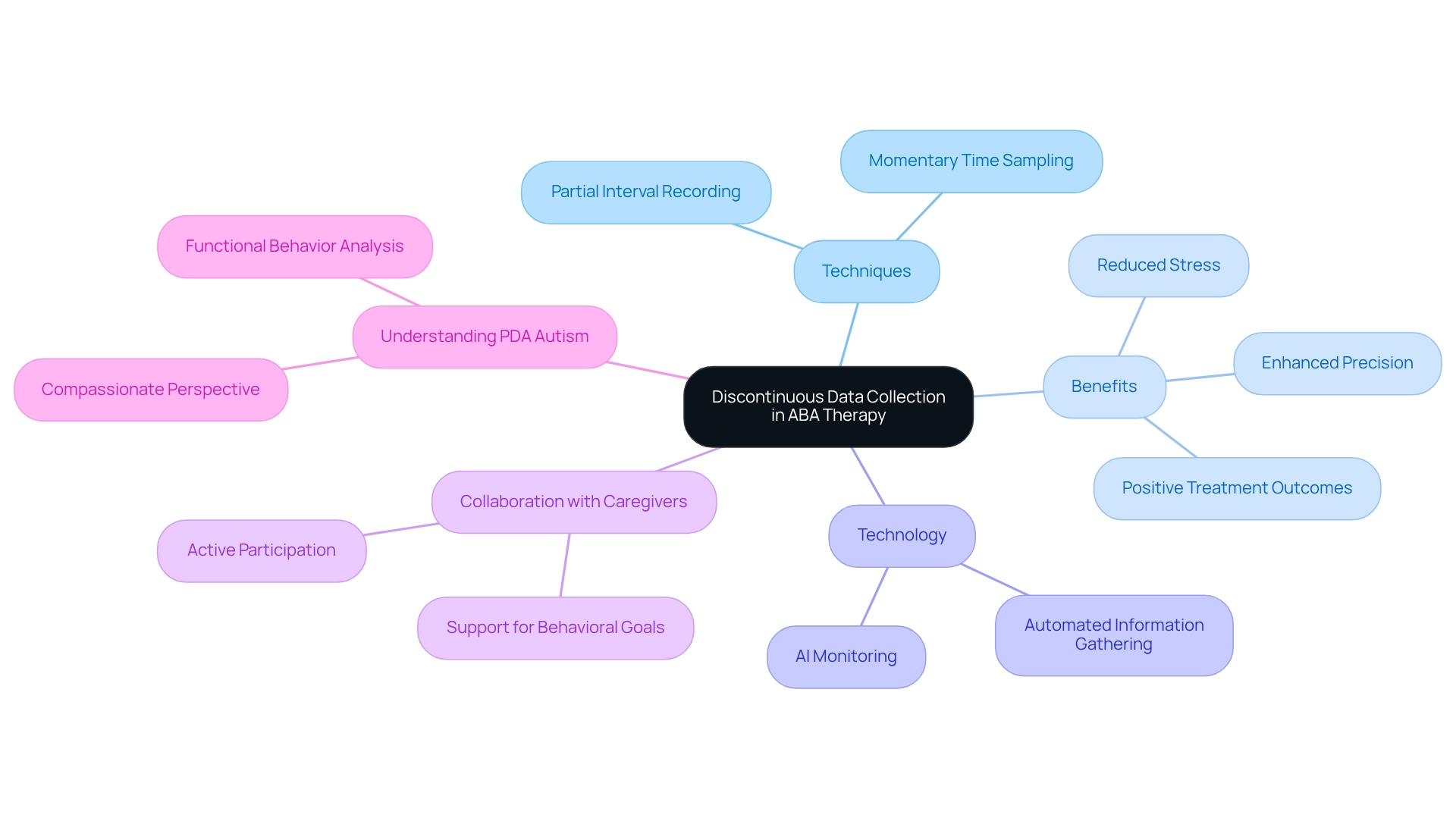
Types of Discontinuous Data Collection: Key Methods Explained
Types of Discontinuous Data Collection: Key Methods Explained
Discontinuous data collection methods are essential tools in ABA therapy, each serving distinct purposes based on the behaviors being monitored. These methods are often designed by qualified behavior analysts who create individualized plans that include measurable goals and evidence-based strategies to foster positive behavior changes.
- Whole Interval Recording: This method requires observers to note whether a behavior occurs throughout the entire interval. It’s particularly effective for measuring behaviors that are expected to be consistent over time. Research indicates that when applied correctly, whole interval recording can yield high effectiveness rates. For instance, in a recent case, Katie's AEB decreased to 73.3% with a 5-minute schedule, while her DB increased to 40%. This shows the impact of schedule thinning on behavior tracking.
- Partial Interval Recording: In this approach, observers record whether a behavior occurs at any point during the interval. This method is especially beneficial for tracking high-frequency behaviors, allowing for a more flexible assessment. Ms. Leonard, a class teacher, emphasized the importance of using the Behavior Intervention Rating Scale (BIRS) and a modified version of the Children’s Intervention Rating Profile (CIRP) to evaluate these behaviors effectively.
- Momentary Time Sampling: This technique involves observers noting whether a behavior is occurring at the end of each interval, providing a snapshot of behavior without the need for continuous observation. This approach is beneficial in environments where continuous oversight is unfeasible, enabling effective information gathering while still providing valuable insights into behavior patterns.
Each of these methods has its strengths and is selected based on the specific behavior being tracked for discontinuous data collection in ABA. For instance, a case study titled "Impact of Schedule Thinning on CBGG" explored the effects of progressively thinning the reinforcement schedule during the intervention, moving from 2-minute intervals to 5-minute intervals. Despite the thinning of the reinforcement schedule, AEB remained high (up to 88.5%) and DB remained low (down to 7.8%), suggesting that the CBGG can maintain its effectiveness even as the frequency of reinforcement is reduced.
Furthermore, incorporating automated information gathering in clinical sessions guarantees that the healthcare team is consistently available for your youngster without pausing to gather information or compose report notes. This approach not only secures the data through secure storage and anonymization but also enhances the efficiency of ABA therapy, allowing for 50% more time dedicated to treatment. Parents are encouraged to seize our complimentary consultation offer to discuss how these methods can be customized to their offspring's unique needs. Understanding these methods is crucial for clinicians and BCBAs in developing effective treatment plans tailored to the unique needs of children with autism.
Train Data Collectors: Ensuring Accuracy in Discontinuous Data Collection
Training individuals who gather information in discontinuous data collection ABA therapy is crucial for ensuring that information gathering is both precise and effective. Let’s take a look at some key elements to consider:
- Clear Protocols: Setting up detailed guidelines for information gathering is crucial. This ensures that everyone is on the same page, which is key to getting reliable results from discontinuous data collection ABA.
- Practice Sessions: Running mock information gathering sessions allows collectors to sharpen their skills in a supportive environment. These sessions are super helpful for refining techniques and boosting confidence. Research shows that practice sessions really enhance the precision of information collection. Collectors who engage in regular practice feel more capable when faced with real-world situations.
- Feedback Mechanisms: Regular feedback is vital for improving precision. Constructive feedback helps collectors identify areas for growth and enhances their overall performance.
- Ongoing Education: Continuous training opportunities are essential to keep collectors updated on best practices and new techniques in ABA therapy. Rori Care offers a comprehensive 40-hour online training program for aspiring Registered Behavior Technicians (RBTs), focusing on foundational principles and practical skills. This commitment to education fosters a culture of excellence.
- Successful Training Programs: Implementing structured training programs tailored for autism care has shown to yield positive results. These programs emphasize practical skills alongside theoretical knowledge, ensuring that collectors are well-prepared.
- Expert Recommendations: ABA professionals highlight the importance of clear protocols and consistent training. Regular observation through discontinuous data collection ABA can reveal whether specific strategies effectively enhance desired behaviors or reduce maladaptive ones, underscoring the necessity for well-trained information collectors. Timing is crucial in this context, as discontinuous data collection ABA measures how long it takes for a behavior to occur after a specific verbal prompt or event, and incorporating technology and innovative information gathering tools in ABA practices can significantly enhance the progress and well-being of individuals with autism. Rori Care combines personalized treatment with advanced AI to monitor and prepare progress reports, freeing up 50% more time for child care. This transformative use of technology boosts the overall efficiency of information gathering initiatives.
By focusing on these elements, organizations can enhance their information gathering efforts, ultimately leading to better outcomes for individuals receiving ABA treatment. Let’s explore this together!
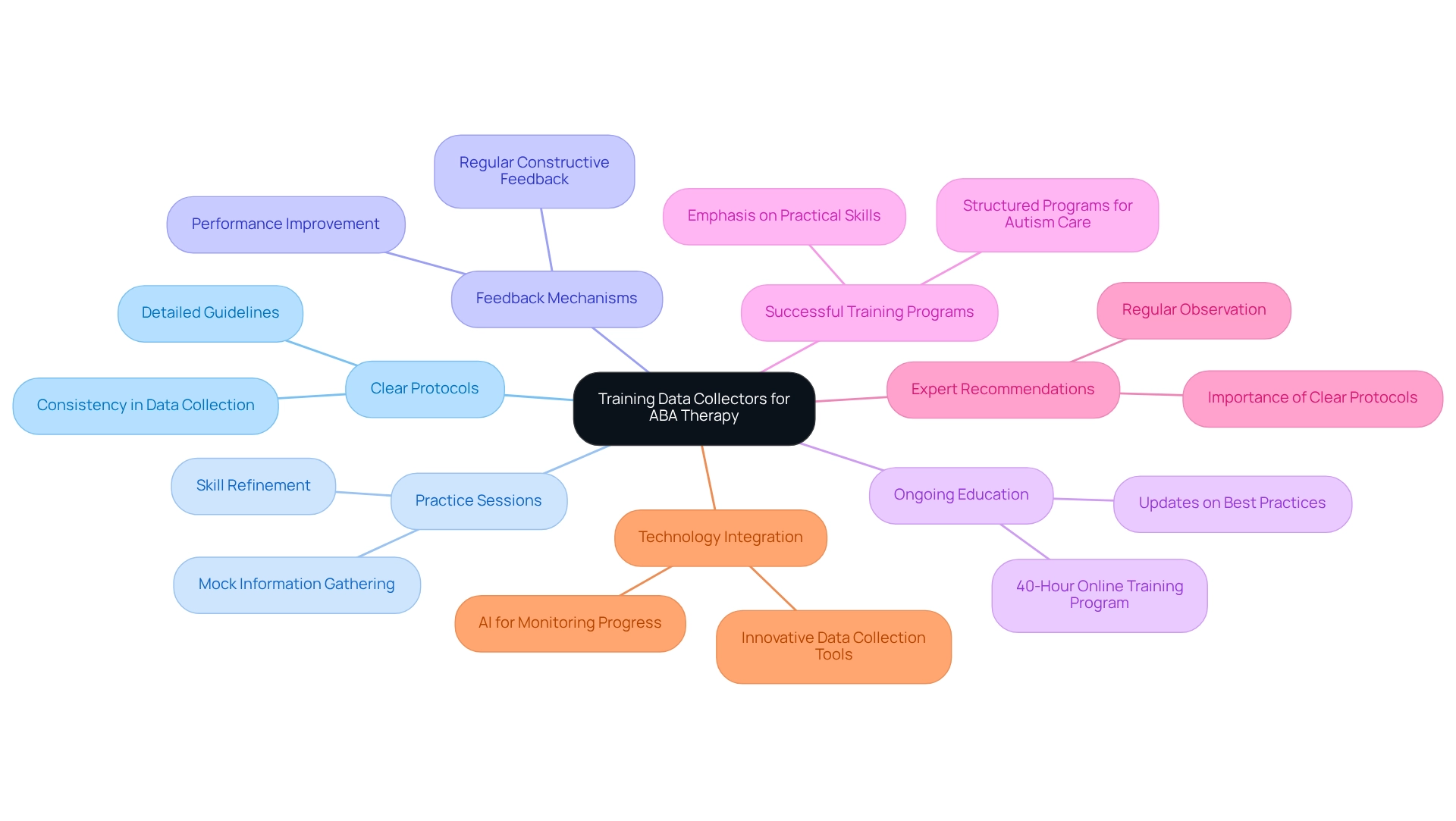
Leverage Technology: Enhancing Discontinuous Data Collection in ABA Therapy
Technology plays a vital role in enhancing the process of discontinuous data collection aba in therapy. With mobile apps and software platforms, entering and analyzing data in real-time becomes a breeze, making the information we gather much more precise. Features like automated reminders and visualization tools help clinicians track progress effectively, reducing human error and ensuring reliable results.
At Rori Care – ABA Therapy, we believe in the power of personalized program development by qualified behavior analysts. They craft individualized plans that focus on measurable goals and evidence-based strategies. This approach not only empowers caregivers with ABA principles but also boosts the overall efficiency of discontinuous data collection aba.
Have you noticed the growing reliance on mobile applications? Recent trends show that their usage has surged by over 50% in just a few years! This shift points to a more effective way of managing information in autism treatment. Experts highlight how these tools can transform our approach, emphasizing that regular monitoring through mobile apps can reveal the success of various strategies in promoting desired behaviors while reducing maladaptive ones. As Rori Care – ABA Therapy puts it, "Frequent monitoring can reveal whether certain strategies are effective in increasing desired behaviors or decreasing maladaptive ones."
Case studies show that technology not only simplifies information gathering but also enriches the therapeutic experience for families. It provides essential resources to support their child's development. At Rori Care – ABA Therapy, we offer articles and tools designed to equip families with knowledge and strategies, reflecting our commitment to enhancing the therapeutic journey.
As we move through 2025, the role of technology in discontinuous data collection aba continues to evolve, promising even greater advancements in ABA treatment. Let’s explore this journey together!
Consider Ethical Guidelines: Upholding Standards in Data Collection
In the world of ABA practices, following ethical standards during information gathering is super important. Let’s take a look at some key practices:
- Informed Consent: It’s vital that parents and guardians fully understand the data collection process. This understanding allows them to provide informed consent, which is a cornerstone of ethical practice in autism therapy.
- Confidentiality: Protecting client privacy is essential. At Rori Care, we make sure that all information is anonymized and securely stored in line with HIPAA regulations. This commitment to confidentiality builds trust, which is critical for nurturing a positive therapeutic relationship.
- Transparency: Clear communication about why we gather information and how it will be used in treatment is key. Families should know how their child’s information will guide treatment choices. We utilize advanced AI technologies, like LLAMA 3 and GPT4v, to enhance our information analysis, ensuring that original recordings are deleted after processing.
- Respect for Autonomy: Involving families in the information gathering process empowers them and fosters collaboration in their child’s therapy journey. At Rori Care, we encourage families to request the removal of information at the end of our services, reinforcing their control over their child's details.
The significance of informed consent in behavioral information gathering can't be stressed enough. Plus, recognizing and celebrating a young person’s progress during therapy boosts positive behavior, encouraging ongoing development and instilling pride in their achievements. As Rori Behavioral Innovations Inc. reminds us, "Evidence-based practice (EBP) is crucial for ethical decision-making and effective treatment for individuals with autism spectrum disorder (ASD)."
Bringing together professional perspectives on ethical principles ensures that practitioners uphold the highest standards in information gathering. This dedication not only improves treatment effectiveness but also aligns with evidence-based practices, which are essential for ethical decision-making in ASD interventions. Parents are encouraged to engage actively in discussions about information gathering with their child’s therapist, asking questions to fully grasp the informed consent process and how their child’s information will be utilized.
Let’s explore this together! We’re here to help you every step of the way!
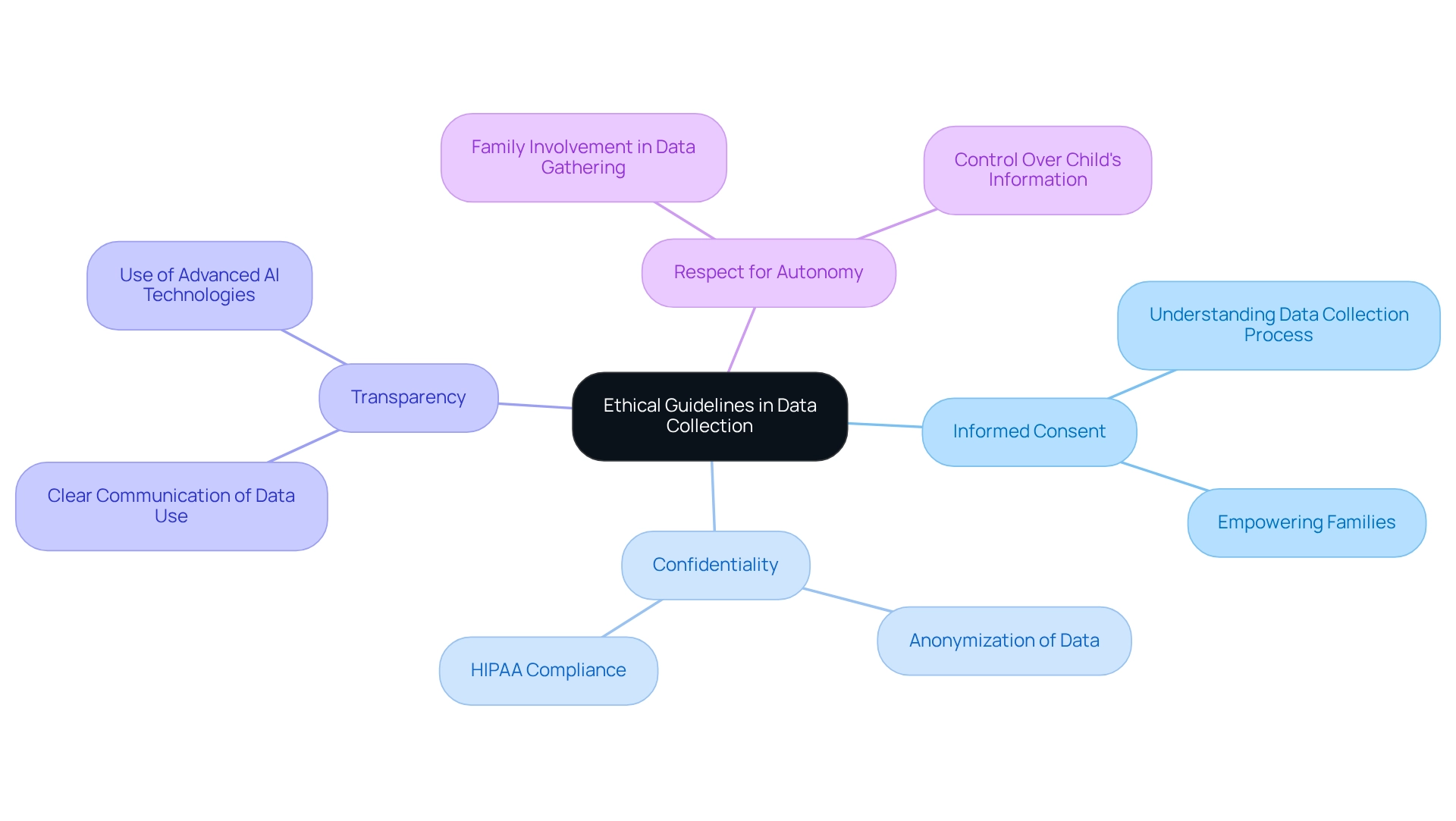
Evaluate and Adapt: Continuous Improvement of Data Collection Methods
Enhancing our information gathering techniques is essential for making ABA treatment even more effective through discontinuous data collection aba. Let’s dive into some key strategies that can help us on this journey:
- Regular Review: It’s important to regularly check in on how we’re gathering information. By utilizing discontinuous data collection aba to assess our methods periodically, we can see what’s working and what might need a little tweak. This ensures that our approach to discontinuous data collection aba remains relevant and effective, especially since each child progresses at their own pace. Patience and ongoing gathering of information are key here!
- Feedback from Gatherers: Don’t forget to ask for input from those who are directly involved in gathering information, like therapists and BCBAs. Understanding the challenges they face and their suggestions for improvement can lead to more effective processes, particularly when considering discontinuous data collection aba, as we take a closer look at how our information gathering techniques relate to client progress. By pinpointing which methods yield the best results through discontinuous data collection aba, we can refine our approaches to better support every child's development. And while there might be critiques, the structured, evidence-based techniques of ABA truly offer personalized, flexible interventions that can foster lifelong growth.
- Flexibility: Staying open to adjusting our information gathering methods based on new research or technology is vital. This flexibility helps us maintain high-quality care and ensures our interventions meet the evolving needs of children by utilizing discontinuous data collection aba. By applying these strategies, we not only enhance the quality of information we gather but also cultivate a culture of continuous improvement within ABA practices. For example, Rori Care’s use of AI-driven progress report automation shows how effective information gathering can foster positive relationships among children with autism, leading to healthier interactions with peers and family. By prioritizing regular assessments and incorporating feedback, we can ensure our techniques are effective and truly in the best interests of our clients. Plus, the statistics on continuous improvement in ABA interventions highlight just how crucial these methods are for achieving successful outcomes. Let’s explore this together!
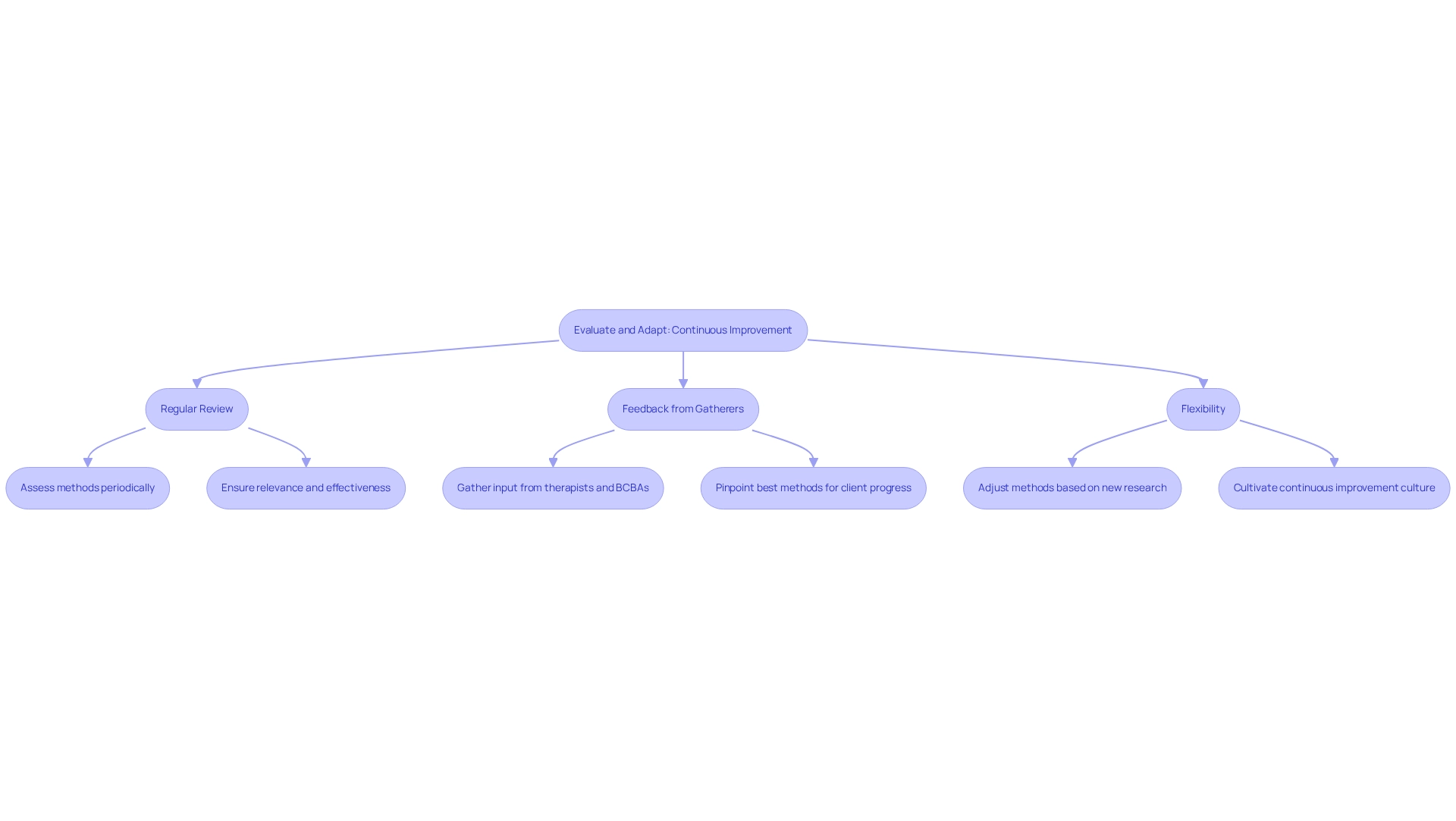
Empower Parents: Supporting Discontinuous Data Collection at Home
To empower parents in supporting discontinuous data collection at home, let’s explore some friendly strategies together:
- Training Sessions: Imagine equipping parents with comprehensive training on effective data collection methods! By utilizing user-friendly tools like charts or mobile apps, they can gain foundational knowledge that’s crucial for accurately tracking behaviors. This aligns perfectly with ABA therapy principles, emphasizing how important caregiver involvement is in informed decision-making.
- Clear Guidelines: It’s essential to provide explicit instructions on which behaviors to monitor and the best practices for recording them. As Rori Care – ABA Therapy says, "Providing clear expectations and consistent routines can also contribute to reducing tantrums." When parents know what to look for, it boosts their confidence in gathering information, ultimately supporting their child’s behavioral goals and leading to better outcomes.
- Regular Check-Ins: Establishing a routine of regular meetings to review the information gathered at home can be so beneficial! These discussions not only highlight the importance of parental contributions but also foster a collaborative approach to the child’s progress. This empowers caregivers with the knowledge and skills they need to make informed decisions.
- Encouragement: Let’s not forget to recognize and celebrate achievements! Positive reinforcement can really motivate parents to stay involved and dedicated to the process, resulting in enhanced behavioral outcomes for their children.
- Expert Insights: Did you know that ABA specialists emphasize the importance of training parents in information gathering? By involving parents, therapists can create a comprehensive approach to the child’s care, ensuring that interventions are consistent and supportive of the patient-centered nature of ABA treatment.
- Impact of Training: Research shows that organized training sessions significantly boost parent involvement in ABA record-keeping, leading to improved behavioral results for kids. For instance, statistics indicate that enhanced parental participation is linked to better adaptability and flexibility in children undergoing ABA treatment.
- Effective Programs: There are some great case studies out there! They show that parent training initiatives centered on information gathering produce amazing outcomes, allowing families to actively engage in their child’s treatment journey. One case study highlights how effective information gathering can enhance coping abilities in children, showcasing the transformative power of parental involvement.
By applying these strategies, parents can truly make a difference in their child’s ABA treatment, nurturing a supportive and developmental environment. We’re here to help you every step of the way!
Identify Challenges: Overcoming Obstacles in Discontinuous Data Collection
Common challenges in discontinuous data collection ABA can significantly impact the accuracy and effectiveness of treatment. Let’s take a closer look at some key obstacles:
- Inconsistent Observations: It’s not uncommon for different observers to record behaviors in various ways, which can lead to discrepancies in data. This makes it tough to get a clear picture of a child's progress. Gathering information during routine activities at home or school is often beneficial, as it provides a more comprehensive view of the young person's behavior in natural settings.
- Time Constraints: We all know how busy life can get! Clinicians and parents often juggle tight schedules, making it hard to collect data consistently. This inconsistency in understanding a young person's behavior over time can be attributed to discontinuous data collection ABA. Thankfully, Rori Care’s advanced AI technology helps automate progress report creation, allowing 50% more time to focus on treatment, which eases some of those time pressures. Plus, data gathering offers proof of achievement that can be shared with families and others involved in the youth's care, emphasizing the importance of steady efforts.
- Behavior Variability: Kids can be unpredictable, right? Fluctuations in a child's conduct can complicate information gathering, as certain behaviors might not happen during the specific times we’re observing, leading to incomplete results.
- Technology Issues: Technical difficulties with information gathering tools can throw a wrench in the process. To tackle these challenges, it’s crucial to provide comprehensive training for users, establish clear protocols for information gathering, and ensure reliable technology is in place to support discontinuous data collection ABA. Addressing these challenges is vital for achieving precise information gathering, ultimately aiding effective ABA therapy. By implementing structured solutions and fostering collaboration among parents and clinicians, we can unlock the potential for significant improvements in a young person's behavior. For instance, a case study titled 'Managing Meltdowns in Kids: A Comprehensive Guide' illustrates how effective management strategies can lead to better emotional regulation for young individuals. This highlights the importance of consistent information gathering in addressing behavioral challenges. The involvement of parents provides a thorough view of the young one's behavior in different environments, further enhancing the efficacy of the treatment.
Let’s explore this together! Your insights and experiences matter, and we’re here to help you every step of the way!
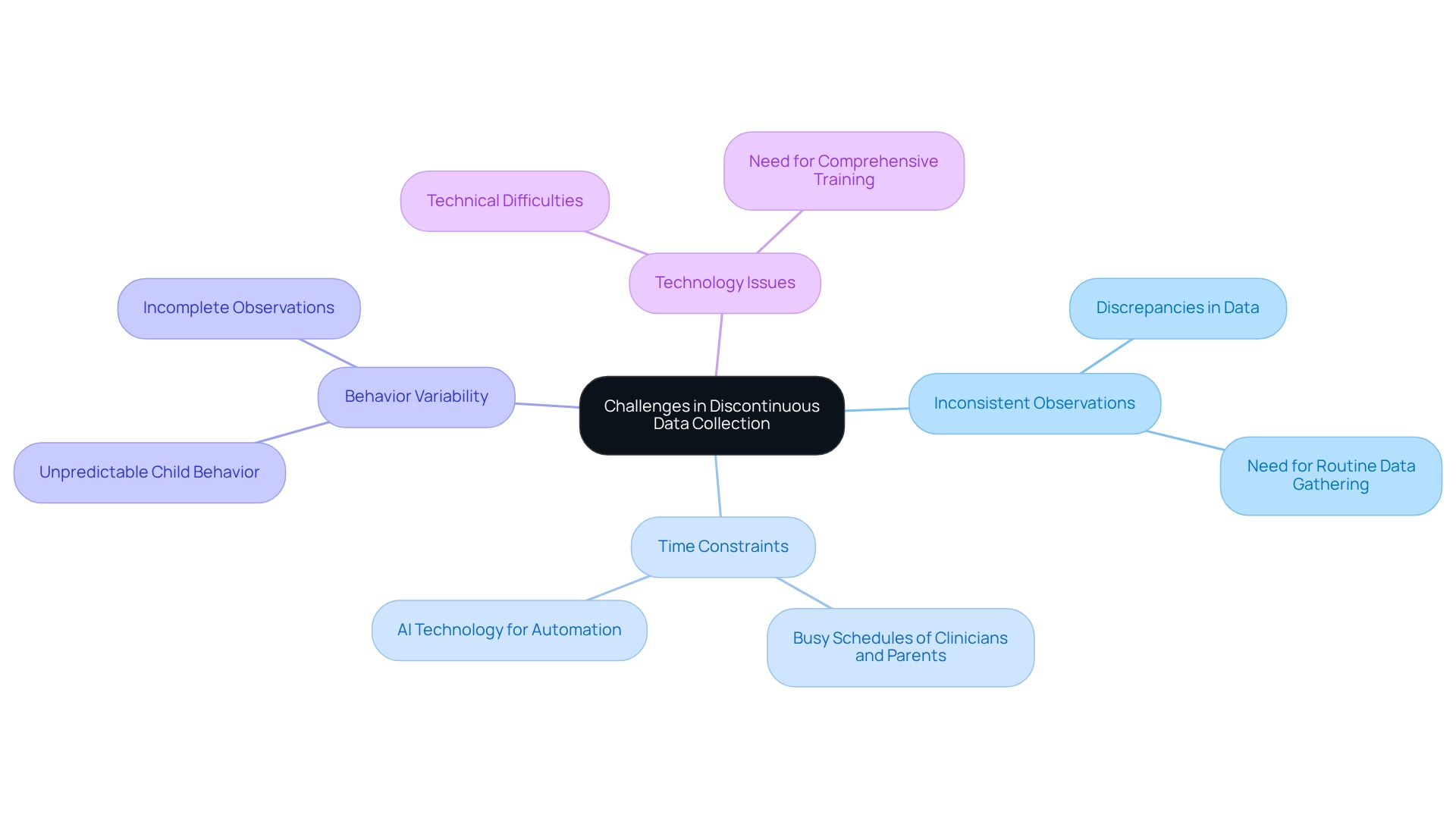
Analyze Data: Interpreting Results from Discontinuous Data Collection
Analyzing results from discontinuous data collection ABA can really enhance our understanding and improve therapy outcomes! Here are some key techniques that can help:
- Data Visualization: Using graphs and charts to show data trends over time makes it so much easier for clinicians and families to see patterns and understand a child's progress. This is especially important in treatments like JASPER, which often involve individual sessions for up to 25 hours weekly. Efficient information analysis is essential for monitoring progress, and Rori Care’s program ensures that each child's unique needs are reflected in these visualizations.
- Comparative Analysis: By looking at information from different time periods or conditions, therapists can effectively assess how specific interventions are working. This allows for informed adjustments to treatment plans. Insights from the case study 'The Evolving Landscape of Autism Statistics' highlight how various factors can influence autism prevalence figures, showing just how important comprehensive analysis is. Measurable goals within Rori Care’s framework provide clear benchmarks for these comparisons.
- Collaborative Review: Involving the therapy team and parents in the evaluation process fosters a deeper understanding of the child's progress and challenges. This collaborative approach ensures that multiple perspectives are considered, enriching the analysis. Recent discussions suggest connecting information sources to enhance understanding further and improve service delivery. Rori Care emphasizes the role of qualified behavior analysts in creating individualized plans, ensuring that caregiver involvement is a key part of the process.
- Actionable Insights: It’s crucial to translate data findings into concrete recommendations. This step helps therapists customize treatment plans more effectively to meet each individual's specific needs, ultimately enhancing the therapeutic experience. As Laura NG, Clinical Operations Manager, points out, understanding the latest autism statistics is essential for developing effective treatment strategies. The ongoing evaluation and modification of plans at Rori Care ensure that insights lead to adaptive treatment strategies based on progress reports and caregiver feedback.
These strategies empower families to make informed choices and promote a more effective and adaptable approach to ABA treatment. Remember, understanding treatment options is vital for families managing their child's care. Let’s explore this together!
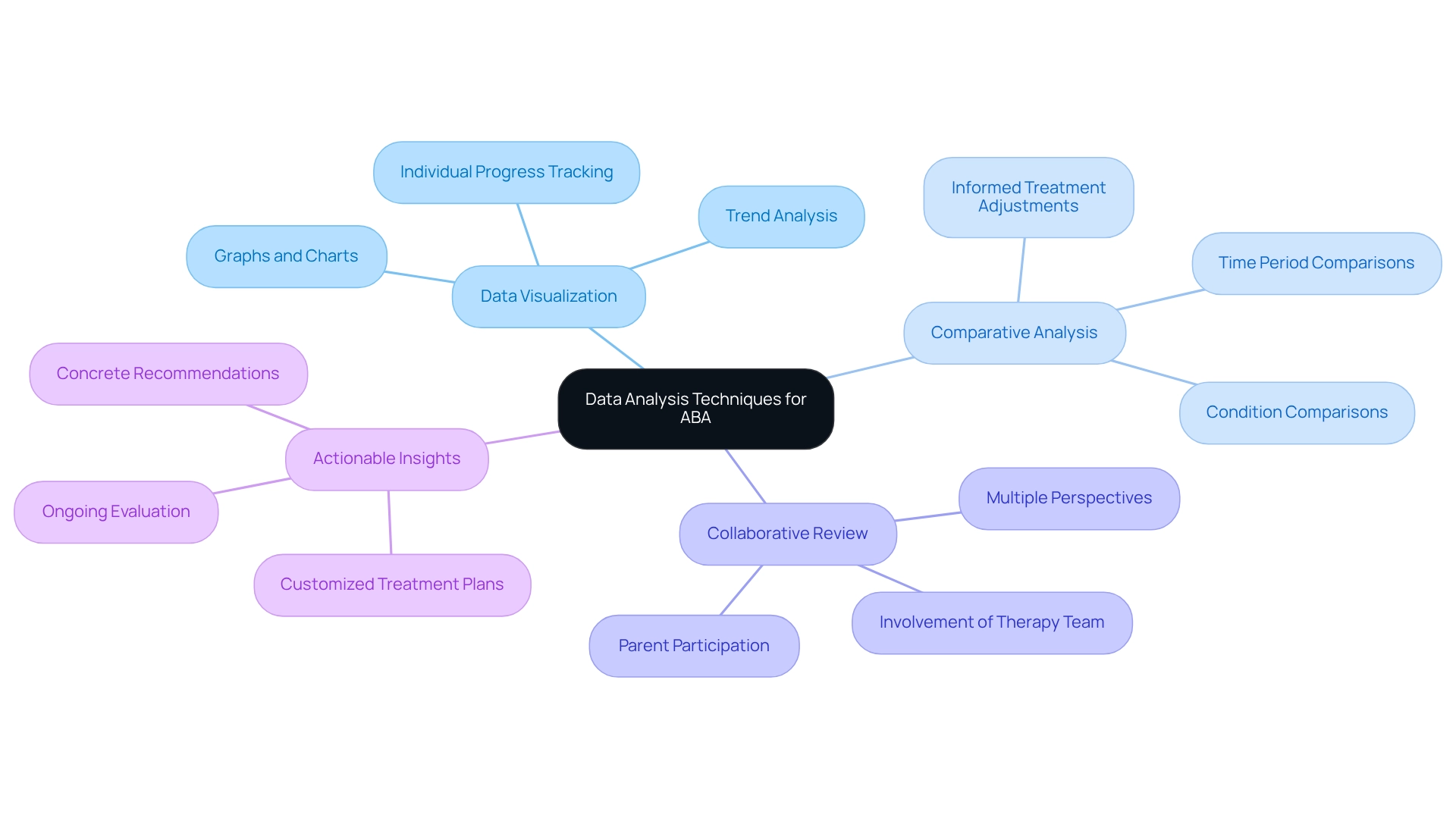
Best Practices: Essential Tips for Effective Discontinuous Data Collection
To ensure effective discontinuous data collection in ABA therapy, let’s consider some best practices that can make a real difference:
- Define Clear Objectives: It’s important to establish specific goals for tracking behaviors. When each objective is precise and operationally defined, it reduces subjectivity and boosts the reliability of the information collected. Research highlights that having clear, functional definitions for each behavior is essential to minimize any ambiguity in information gathering.
- Use Consistent Methods: Sticking to the same information gathering techniques consistently helps foster reliability. Plus, it allows for more accurate comparisons over time, which is super helpful!
- Regular Training: Continuous training for information gatherers is key. Keeping their skills sharp and knowledge current is essential for maintaining high standards in information gathering. After all, we all want the best for our kids!
- Engage Parents: Actively involving parents in the data collection process is a game changer. Their engagement not only enhances their understanding of the treatment but also empowers them to support their child's development effectively. As Rori Care emphasizes, equipping caregivers with knowledge and skills aligned with ABA principles maximizes the intervention's impact. Just listen to Aisha and James L.: "Move Up ABA has been a lifeline for our family. Before beginning treatment, our son struggled with daily routines and communication. Now, he’s more independent and even initiated a conversation with a classmate for the first time! The progress we’ve seen in just six months is truly remarkable."
- Review and Reflect: Regularly analyzing the gathered information is crucial. Reflecting on its implications for therapy allows for timely adjustments to treatment plans, ensuring they stay aligned with the child's evolving needs. Rori Care's behavior care engine refreshes intervention and skill acquisition strategies based on progress report information, highlighting how adaptive treatment plans can make a difference.
- Automated Information Gathering: Using automated information gathering techniques can streamline the process. This way, the clinical team can oversee sessions without disrupting treatment. Plus, it ensures secure storage of information, which is anonymized and erased after analysis, maintaining confidentiality while providing valuable insights for treatment modifications.
Implementing these strategies can significantly enhance the efficiency of discontinuous data collection in ABA, leading to improved outcomes in autism therapy. For example, utilizing momentary time sampling in classroom settings has proven beneficial for monitoring on-task behavior, giving educators and therapists valuable insights for informed decision-making. Also, mands can help reduce frustration, encourage independence, and foster social growth in children with autism. This underscores the importance of effective data collection methods in promoting positive developmental outcomes.
Let’s explore this together! By embracing these practices, we can create a supportive environment that truly benefits our children.
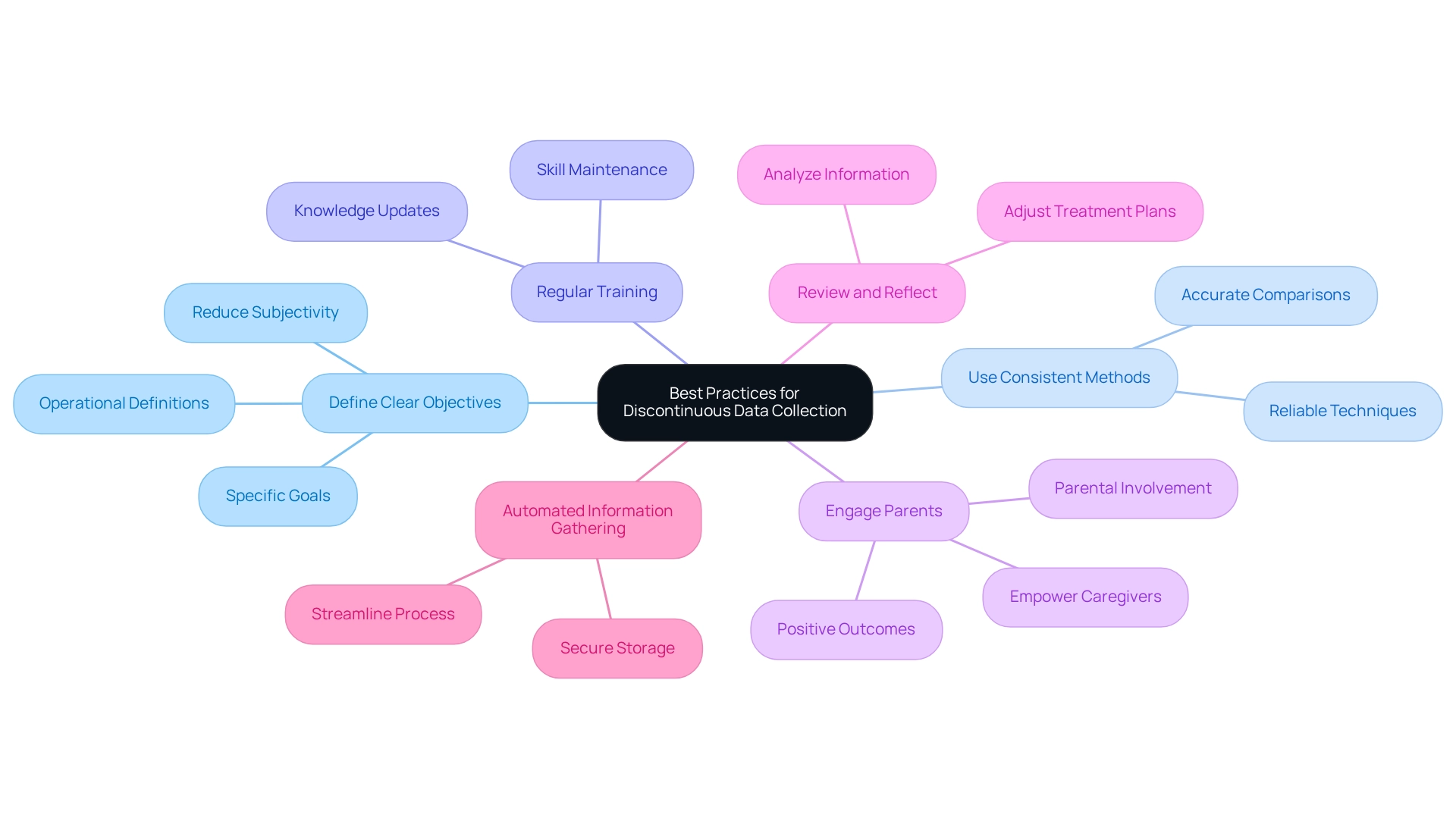
Conclusion
Implementing effective discontinuous data collection strategies is vital for enhancing the quality of ABA therapy interventions. Through methods like partial interval recording and momentary time sampling, Rori Care – ABA Therapy streamlines the data collection process. This ensures accurate insights while minimizing stress for both clinicians and children. Plus, the integration of advanced technology not only facilitates seamless data entry but also empowers caregivers to play an active role in their child's therapy.
Moreover, we can't overlook the importance of ethical guidelines and ongoing training. Upholding standards like informed consent and confidentiality fosters trust and collaboration between families and therapists. When parents engage in data collection, it enhances their understanding and leads to better therapeutic outcomes for their children. This is supported by numerous case studies that show the positive impact of parental involvement.
As ABA therapy continues to evolve, embracing continuous improvement and leveraging technology will remain paramount. By regularly reviewing data collection methods and adapting to new findings, clinicians can ensure that interventions are tailored to meet each child's unique needs. This dynamic approach fosters independence in children with autism and creates a supportive environment where families can thrive alongside their children’s development.
Ultimately, the journey of effective data collection is a collaborative effort that transforms lives and empowers families. Let’s explore this together! We’re here to help you every step of the way!
Frequently Asked Questions
What is the purpose of using structured methods for discontinuous data collection in ABA therapy at Rori Care?
The structured methods for discontinuous data collection in ABA therapy at Rori Care aim to simplify the information-gathering process, making it less overwhelming for clinicians and young patients. Techniques like partial interval recording and momentary time sampling allow for effective behavior tracking while minimizing stress.
How do techniques like partial interval recording and momentary time sampling work?
Partial interval recording captures whether a behavior occurs at any point during a specified interval, making it suitable for high-frequency behaviors. Momentary time sampling records whether a behavior is occurring at the end of each interval, providing a snapshot of behavior without continuous observation.
What are the benefits of automated information gathering in ABA therapy?
Automated information gathering enhances efficiency by allowing clinicians to document sessions effortlessly, freeing up 50% more time for treatment. This ensures that sessions are uninterrupted for note-taking and that data is securely stored and anonymized.
How does Rori Care ensure the privacy and compliance of data collected during ABA therapy?
Rori Care ensures privacy and compliance by securely storing, anonymizing, and deleting information after analysis. This approach prioritizes the confidentiality of the data collected during therapy sessions.
What role does advanced AI technology play in ABA therapy at Rori Care?
Advanced AI technology is used to monitor sessions and prepare progress reports, which helps increase efficiency and effectiveness in treatment. It allows caregivers to better understand ABA principles and support their child's behavioral goals.
How does Rori Care address the challenges faced by individuals with Pathological Demand Avoidance (PDA) autism?
Rori Care integrates functional behavior analysis into their discontinuous data collection strategies to effectively customize interventions that address the specific challenges faced by individuals with PDA autism.
What are the different types of discontinuous data collection methods used in ABA therapy?
The main types include: - Whole Interval Recording: Observers note if a behavior occurs throughout the entire interval, effective for consistent behaviors. - Partial Interval Recording: Observers record if a behavior occurs at any time during the interval, suitable for high-frequency behaviors. - Momentary Time Sampling: Observers note if a behavior is occurring at the end of each interval, useful for environments where continuous observation is not possible.
Why is training for individuals who gather information in discontinuous data collection important?
Training is crucial to ensure that information gathering is precise and effective. It involves clear protocols, practice sessions, feedback mechanisms, ongoing education, and structured training programs to enhance the skills of those collecting data.
How can parents get involved in their child's ABA therapy at Rori Care?
Parents are encouraged to actively participate in the planning and assessment process, collaborating with clinicians to support their child's development and understanding the information-gathering techniques used in therapy.






